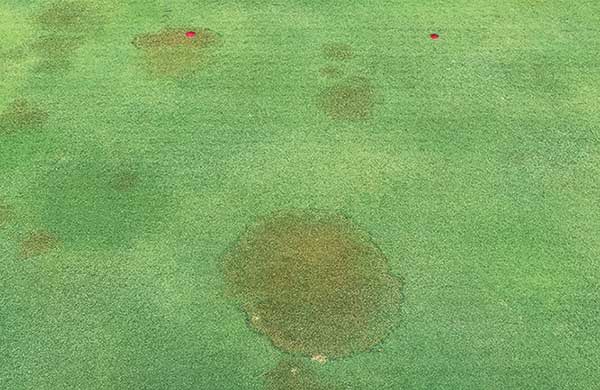Battling brown patch

Brown patch shows up as irregular or circular patches of turf with a brown or tan color in the middle. (Photo: NC State University)
Brown patch gets its name from the tan or brown color that appears in the middle of irregular or circular patches of turf, according to Jim Kerns, Ph.D., associate professor and Extension specialist at NC State University.
“A smoke ring or dark brown or black border may be evident early in the morning. The smoke ring is usually only visible on turf mowed at a half-inch or less,” Kerns says. If superintendents are unsure about the diagnosis, they should look for the characteristic lesions on the leaves.
“(Lesions) would only be visible on fairway- or roughheight turf,” he says. “The lesions are irregular in shape, are brown in the middle and have a purple or chocolate brown border.”
The disease is most prevalent when nighttime temperatures are above 70 degrees F and humidity is high. It’s usually a summertime disease for cool-season grasses. “It is important to note that brown patch only occurs on cool-season grasses,” Kerns adds. “(Also), brown patch was thought to be a high N disease, but our research has demonstrated the diseas is related to growth potential rather than N amount.”
Cultural practices to help reduce brown patch include removing dew, sand topdressing, aerifying, reducing leaf wetness periods by limiting irrigation late in the afternoon, providing air movement and making sure there’s adequate surface and subsurface drainage. Applying wetting agents can also aid in reducing the disease.
Kerns adds that brown patch is easily managed with certain QoI fungicides, which routinely provide 28 days of suppression in trials. He notes that fungicide resistance is unlikely to develop.

Paul Giordano (Photo: Bayer)
Bayer
Paul Giordano, Ph.D.
Green Solutions Team member
The pathogen for brown patch (Rhizoctonia solani) can grow and infect rapidly when temperatures rise into the mid-80s and especially when nighttime temperatures are in the 70s with high humidity. Superintendents can manage brown patch effectively by closely monitoring weather conditions and acting in advance of an outbreak. During or just prior to the onset of heat and humidity, avoid excessive nitrogen fertilization. Removal of morning dew or guttation water will also help reduce severity of the disease given its propensity for moist, humid microenvironments. The QoI (strobilurin) fungicides like trifloxystrobin are highly effective in managing brown patch and can be used alone or in combination with other actives to broaden disease control. Careful selection of the proper fungicide is important, considering that certain classes like succinate dehydrogenase inhibitors and demethylation inhibitors contain some active ingredients that are ineffective against brown patch.

Rick Fletcher (Photo: Nufarm)
Nufarm
Rick Fletcher
Technical services manager,turf and ornamentals
Brown patch is a disease of cool-season grasses, including bentgrasses, bluegrasses, fescues and ryegrasses, that occurs when minimum air and soil temperatures exceed 64.4 degrees F and 59 degrees F. Periods of high relative humidity (greater than 95 percent) for at least 10 consecutive hours are required for disease development. When turf managed at golf course heights is wet, brown patches are often surrounded by a dark brown or gray ring called a “smoke ring,” evidence of active fungal growth on the turf foliage. The turf may recover when disease pressure is reduced by a change in weather conditions or implementation of control practices. In general, factors that impede evaporation or drainage (poor air movement and soil drainage, excessive shade) are conducive to brown patch. Excessive nitrogen fertilization creates dense, lush turf that is highly susceptible to R. solani. Frequent use of organic fertilizers has also been associated with increased brown patch severity.

Ian Rodriguez (Photo: Quali-Pro)
Quali-Pro
Ian Rodriguez, Ph.D.
Technical services manager
Turf recovery from brown patch is typically slow in cool-season turf since disease pressure coincides with slower growth rates on the calendar. Avoid applications of more than .5 lb./1,000 ft2 of soluble N by spoon-feeding at lower rates during peak pressure periods. Reduce the duration of leaf wetness by early morning irrigation or whipping dew. Increase air circulation and light to promote a drier surface by strategically pruning or making alterations in the landscape.

Mike Agnew
Syngenta
Mike Agnew, Ph.D.
Technical services manager
Brown patch is more severe during extended periods of hot, humid weather. Poor soil drainage, lack of air movement, overwatering and excessive nitrogen can contribute to its development. Minimize leaf wetness, avoid late-evening irrigation and increase air circulation by selective pruning. Morning dew removal is also helpful. Avoid nitrogen applications when brown patch is active. Using low-to moderate amounts of nitrogen when the disease isn’t active is important for plant health. For control, apply penetrant fungicides.

Mark Semm (Photo: BASF)
BASF
Mark Semm
BASF turf experience projectmanager
Brown patch (Rhizoctonia spp.) thrives during hot, humid times of the growing season. It is prevalent on cool-season turf. It’s a moisture-loving disease. Employ agronomic tools to keep a drier surface and soil profile such as venting, dew removal, moisture monitoring and improving air movement. There are a number of fungicides to help prevent brown patch. This includes, but is not limited to, products containing pyraclostrobin and/or fluxapyroxad.












